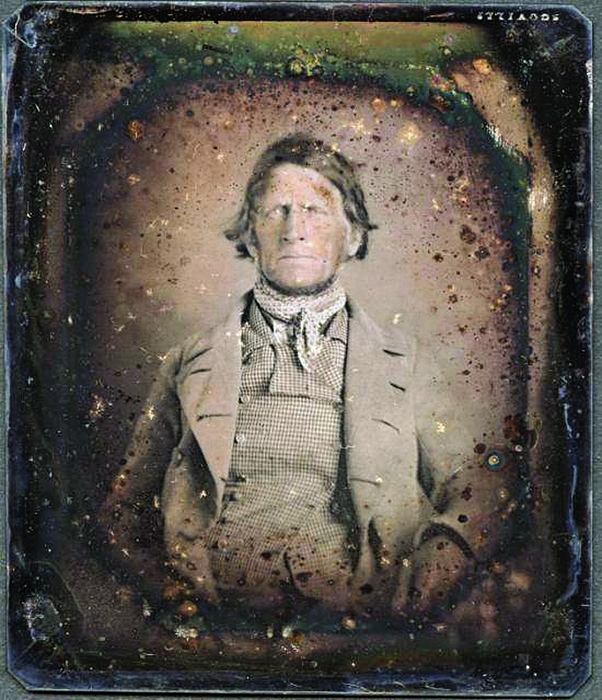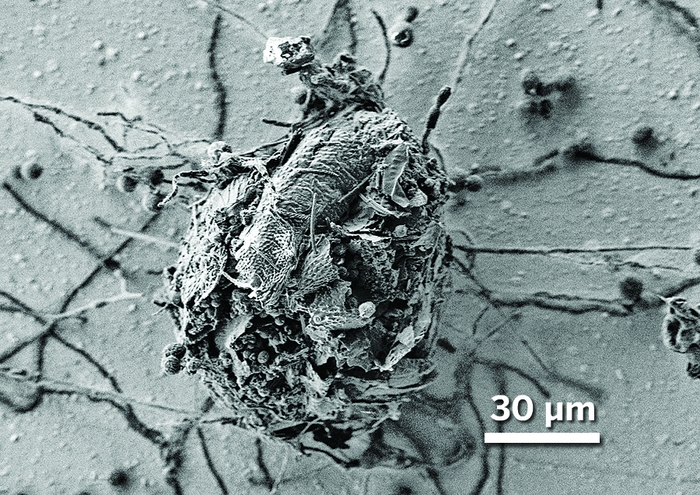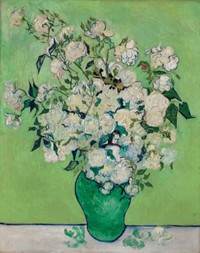Advertisement
Grab your lab coat. Let's get started
Welcome!
Welcome!
Create an account below to get 6 C&EN articles per month, receive newsletters and more - all free.
It seems this is your first time logging in online. Please enter the following information to continue.
As an ACS member you automatically get access to this site. All we need is few more details to create your reading experience.
Not you? Sign in with a different account.
Not you? Sign in with a different account.
ERROR 1
ERROR 1
ERROR 2
ERROR 2
ERROR 2
ERROR 2
ERROR 2
Password and Confirm password must match.
If you have an ACS member number, please enter it here so we can link this account to your membership. (optional)
ERROR 2
ACS values your privacy. By submitting your information, you are gaining access to C&EN and subscribing to our weekly newsletter. We use the information you provide to make your reading experience better, and we will never sell your data to third party members.
Saving Endangered Photographs
Scientists use the molecular makeup of million-dollar masterpieces and family snapshots to conserve and authenticate them
by Sarah Everts
February 25, 2013
| A version of this story appeared in
Volume 91, Issue 8

Fifteen years ago, two fraud cases sent shock waves through the world of photography, helping to trigger a revolution in photo conservation science.
Long dismissed by the art establishment as a second-tier medium, “photography used to fight for space in galleries,” says James M. Reilly, director of the Image Permanence Institute in Rochester, N.Y. But by the 1990s the prestige—and price tags—of photographs began to approach those of paintings and sculpture. During that decade, collectors increasingly paid out hundreds of thousands and then the first million dollars for vintage and contemporary photographs. Yet, as in all coming-of-age stories, life’s dark side made an appearance, this time by means of back-to-back fraud cases.
In 1998, researchers in Germany discovered that a collection of prints by the avant-garde American photographer Man Ray had not been made by the artist himself. A year later, a team in the U.S. began to scrutinize a collection of 20 prints by Lewis Hine, an early-20th-century American documentary photographer. They discovered that the iconic collection of photos of Empire State Building construction sites and child laborers, purported to have been printed by Hine himself, were made decades after his death. Both cases led to million-dollar settlements that helped stimulate the photo conservation research, transforming a niche field into a mature science.
“The market drives conservation research,” Reilly says. “If you said, ‘Would you please analyze my $5.00 photograph with a $300,000 machine?’ the answer would be, ‘Well no, not today.’ But the market has reached a point where a photograph that was made in the 20th or 21st century sells for $3 million.”
Getty Conservation Institute's Art Kaplan takes us through the wonderful and wacky world of photograph conservation science.
Interest in photo conservation research has grown to reflect this trend. Scientists are now teasing apart the intricate marriage of chemistry and physics that is to blame for the deterioration of a wide variety of photographs, everything from historical daguerreotypes and silver gelatin masterpieces to common color snapshots found in family albums. Understanding the molecular makeup and the ailments of precious images can help owners fight both the insults of time and counterfeit crime.
The fraud cases were both “a real shock and a revelation,” says Paul Messier, a photograph conservator involved in uncovering the Hine fakes. In 1999 Messier was approached by a collector and physicist, Michael Mattis, who was very eager “to get to the bottom of rumors about counterfeited Lewis Hine prints,” Messier says.
The question was not whether Hine had taken the photos; the question was whether he himself had produced the prints of the image. This detail is inherent to the value of a print. If Hine hadn’t printed the photographs himself, they were almost worthless. If he had, each of the 75 fake prints Messier eventually caught could have been sold for tens of thousands of dollars.
Although Messier had been working for more than a decade in photograph conservation when he was first approached about the suspected counterfeits, there were no established ways to authenticate the Hine prints—nor any other famous works of photography. “I just didn’t have the tools,” Messier says. “Here I was a photograph conservator, an expert in the field, and I couldn’t tell you whether the objects in front of me pre- or postdated Hine’s death,” Messier says.

So Messier teamed up with a private forensic scientist and Mattis to uncover three pieces of evidence showing the photographs couldn’t possibly be authentic Hine prints.
All the damning data came from the paper. The black-and-white images were so-called silver gelatin prints, the 20th century’s most popular form of professional photography, and one that Hine had also favored. When the team looked at the paper, they found it contained optical brighteners. These molecules, often based on a stilbene backbone, absorb ultraviolet radiation and reflect it in the blue area of the spectrum, giving images a brighter look. But photopaper companies only began using optical brighteners in the late 1950s, nearly two decades after Hine’s death.

Another clue came from the paper fiber. Messier’s team discovered it was not made from cotton rag fibers common during Hine’s era but from more modern wood pulp instead. Furthermore, the team caught sight of a small backprint stamp from the photo paper maker that corresponded to stock issued after Hine’s death.
“It was clear that they were fakes,” Messier says.
The irony, Messier says, is that the German research team working to discover the Man Ray fakes had independently “come up with the exact same three criteria” for their authentication.
These cases galvanized the field. Hoping to develop a vision for photo conservation science, the Getty Conservation Institute sponsored a workshop the following year in Rochester. “Everybody was invited,” Messier says. “We were all asked to stand up one by one and present what we thought the most important research topics for the field should be.”

The key idea that came out of that meeting was that the field should focus on identifying and characterizing every photographic process, Reilly says. Participants agreed that sophisticated understanding of the chemical and physical makeup of different kinds of photos could inform future authentication issues; it would help conservators monitor the degradation of photographs; and it would help museum staff choose the best conditions for storing and displaying photos in exhibitions so that further degradation could be mitigated.
This may sound like a pretty straightforward—possibly even a simple—plan of action. In practice, it is anything but.

Since the Frenchman Joseph Niépce first captured a view from his window in Burgundy in 1826, photo enthusiasts have invented a bonanza of different processes for creating snapshots. “You’re talking about 150 different photographic processes in less than 200 years,” says Art Kaplan, a conservation scientist with the Getty Conservation Institute.
Paper rose to dominance in the 20th century as a substrate of choice, but photographers also have invented processes to produce images on glass, leather, copper, tin, and even ceramic.
Then there’s the image itself. “Throughout the history of photography, images based on a variety of silver processes dominate,” says Debra H. Norris, a photo conservator who teaches at the University of Delaware. But there are also photographic images made with other metals, including platinum, palladium, or iron. And there are those composed of organic pigments and dyes, as well as Polaroids, “where you’re talking about 21 to 22 layers of chemical materials that all interact to create the image,” Kaplan says.

Among the myriad photograph processes, two overarching strategies are used to get the image onto the substrate. Initially, photographers used light to directly etch images onto a substrate, usually by covering the substrate with some sort of photosensitive layer that reacts in proportion to the light being reflected off the objects getting photographed. As cellulose acetate and cellulose nitrate film were invented, photographers first captured images on film and then created prints on substrates through chemical processes, instead of directly with sunlight.

To add another layer of complexity for researchers, “photographers were often mixing processes,” says Bertrand Lavédrine, director of the Research Center for Collections Conservation, in Paris. So sometimes a photograph is a hybrid or superposition of techniques. Particularly in the early days of photography, before there were commercial companies and photographic studios, “people were really doing kitchen chemistry,” Kaplan says. “People were just starting to realize they could capture permanent images and so there was a lot of experimentation happening in back rooms.”
To make things even more challenging for researchers “a lot of photographs made with different processes can look remarkably similar,” Kaplan says. “And if you don’t know what you have, you don’t know how to display, conserve it, or store it without causing some sort of damage to the image.”
A case in point, Norris says, is the difference between gelatin-based silver prints and collodion-based silver prints. Both are printed on paper, and both rely on silver salts to produce a black-and-white image. The only difference is whether the silver salts are suspended in gelatin on the paper or whether they are suspended in collodion, which is a solution of cellulose nitrate in ether and alcohol. Say conservators want to clean dust from the surface of a collodion print. If they erroneously think it is a gelatin print, they might use acetone, causing irreversible damage to the image, Norris says. To distinguish between collodion and gelatin, conservation scientists can use Fourier transform infrared spectroscopy (FTIR) to look at the fingerprint spectrum produced by vibrating bonds in the different materials.

Another workhorse technology used in photo research is X-ray fluorescence, which can identify the heavy elements used to create or change the tint of a photograph. For example, XRF is the only tool capable of determining whether a photograph is made from a platinum process or a palladium one. Researchers can also use the technique to detect trace mercury on the image. Its presence stems from mercury bichloride in the chemical baths used to intensify the image on some black-and-white prints. But its long-term presence is sometimes to blame for the brownish tinge, called sepia, found on old black-and-white photographs.

XRF has also been useful in dating and authenticating silver gelatin prints. Early on in commercial photography, around 1880, many companies began adding a barium sulfate and strontium-based coating known as a baryta layer to their photo paper, Norris says. This layer provides a reflective surface that improves the look of photos. It also creates a boundary between the image layer and the paper layer, so that no trace contaminants in the paper can migrate into the image layer and discolor or damage it.

Although the baryta layer was common across many manufacturers, the relative concentration of barium and strontium in the layer can finger a particular manufacturer in a particular era, explains Dusan Stulik, a Getty Conservation Institute researcher who developed an XRF-based technique for measuring such ratios in collaboration with Messier. This ratio can be useful in authentication because many photographers were loyal to certain brands. Furthermore, given that some manufacturers changed their baryta formulations over time, barium-to-strontium ratios can help date a paper.

Radiocarbon dating can also be used to figure out whether a silver gelatin image was produced before or after the 1950s. That’s when aboveground nuclear testing changed carbon-14 levels in gelatin, which is typically taken from animal sources, Messier says.
But microscopy is the real tool of choice among photo researchers. For example, if you can clearly see paper fibers on an image using an optical microscope, this indicates that the image is embedded in the paper rather than suspended in albumen or gelatin binder layers, Norris says.
Another kind of microscopy, electron microscopy, is useful for observing degradation processes, which can in turn help identify the process used to make the image. For example, it’s common for silver to precipitate out of aging silver gelatin prints, Norris says. A wide variety of factors—from high humidity to airborne pollutants—can oxidize the elemental silver in the photograph, turning it into a form that can migrate through the gelatin layer until it reaches the photo’s surface where it gets reduced back to elemental form. The result is shiny silver “mirrors” or blemishes in the image. “There’s no unscrambling that egg,” Reilly says. “Once the particles have rearranged themselves, who’s going to put them back to where they were?”

Conservators have various ways of removing the silver mirroring or masking the distracting shine with microcrystalline wax. But many are increasingly circumspect about treating heavily mirrored photos because some interventions are not reversible, and thus permanently alter an object of cultural value. What’s more, a photograph can also lose financial value when significant changes to the original have been made.
For example, sensual photographs of peppers made by Edward Weston can sell for as much as a half-million dollars, Reilly says. A few years ago, a vintage Weston print went on the market. But the print was eventually withdrawn from auction when potential buyers balked after reading conservation papers, which detailed extensive and ill-advised treatments to remove silver mirroring.
Advertisement
To avoid silver mirroring and other degradation in silver gelatin prints in the first place, the best idea is to keep the photos in a dry environment at room temperature, Lavédrine says. Scientists are also trying to fight fading in color prints, such as so-called chromogenic photographs, which dominate prints in family photo albums—and some artists’ catalogs—from the 1950s through the 1990s. Lavédrine notes these photographs are so fragile that they “fade in the dark and they fade in the light.”
Moldy Authentication

A daguerreotype forger must try to emulate 100-year-old fungal colonies to get past the watchful eye of Ralph Wiegandt, a conservation scientist at George Eastman House. It turns out that these mirrorlike photographs, which were popular in the 19th century, actually have a surface that’s more like a gravel pit of gold and silver nanoparticles. “It’s one of the first forms of photography, but it’s also one of the first forms of controlled nanotechnology,” he says. As these nanoparticles form, small empty inclusions are created just below the surface that fill with dust and other biogenic particles. “I haven’t seen a single daguerreotype that doesn’t have some fungi growing in these inclusions,” Wiegandt says.


It’s actually two different fading processes, he says. When exposed to light, chromogenic photos often take on blue tones. When kept in the dark, the cyan dyes in such photos degrade, shifting the photo tint to a reddish purple. “The exact color shift depends on the dye chemical used by a particular manufacturer,” he says. Although the dyes vary from manufacturer to manufacturer, this problematic fading exists for most brands that existed in the second half of the 20th century.
Given that degradation of these popular color photographs is inevitable, the only real solution is to slow down the process through cold storage, Lavédrine says. “This is feasible for a big museum, but it may not be feasible for smaller museums or museums in developing countries that can’t afford the high energy bills,” he says. As for family photographs, “most people are not going to store their family album between the cheese and the milk,” even if that’s the safest idea, he says. “So we are losing a huge part of the cultural heritage.”
Meanwhile, most people have turned to digital photography. Although the general public now prints only a tiny fraction of their photos, professional photographers still make prints. And when either wants a physical copy, the common technique is to use ink-jet printers. The big question in photography circles is defining the vulnerabilities of these prints, Reilly says.
“We still don’t know exactly how well these things are going to hold up,” he says. But initial research suggests that one potential problem has to do with the fact that the photograph’s dye lies on top of the paper. The printers “squirt the ink, which is water soluble, onto a mineral-gel layer on the paper. The water drains down through the mineral-gel layer quickly, but the colorants stay on top,” Reilly explains. The problem is that the dyes remain on top and are not encased in anything like gelatin. So the image is easily rubbed or abraded.
Furthermore, because the dyes are water soluble, moisture is a problem. Even nearly invisible droplets of saliva from someone speaking too close to the image can cause havoc, Reilly says. “Or if you are in Florida and it’s humid, the photos can bleed so that images lose their definition.”
Some people choose to spray images with polymer coatings, Reilly says. The problem, he says, is that the exact recipe for the polymer coatings “are proprietary, and so you are not sure what you are dealing with. Some haven’t performed well in the past.”
In fact, the continued secrecy of many companies about their materials and processes frustrates many conservators. “After photography ceased to be a ‘do it yourself’ activity and became a large-scale industry, a wall of secrecy and misdirection was erected concerning its exact technologies,” Reilly says. This means researchers have sometimes had to reverse engineer particular commercial processes before they could fully unravel deterioration pathways.
Conservation researchers have made enormous headway in their quest to decode the secrets of vintage photographs. Nevertheless, they face new challenges, such as how to use the vast amounts of information garnered about existing photographic processes to inform museum collecting, authenticating, storing, and exhibiting practices, Messier says. At the Getty Conservation Institute alone, “we’ve analyzed 10,000 images of a variety of processes,” Kaplan says. He says he’s working with colleagues to organize the profusion of data into a tome that will be a comprehensive reference for all forms of photography and that will hopefully be a resource to museum research staff, Kaplan says. “The whole idea is to change [museum] practices,” Messier says. “Gathering thousands of spectra is not the end but just a start.”

Then there’s the challenge of how to preserve “the billions of digital images” created since the advent of digital photography and which are stored in a variety of formats and on memory hardware that could eventually become obsolete and thus lost to history, Lavédrine says.
As photo researchers work hard to keep up with the evolving nature of the medium and its conservation challenges, the overarching goals of the photo conservation community are perhaps best spelled out by Henry Wilhelm, a pioneer of photo research: “The mere act of taking a picture is preserving a moment in time,” he said. “Our work is to preserve that moment as long as possible in the best possible condition.”






Join the conversation
Contact the reporter
Submit a Letter to the Editor for publication
Engage with us on Twitter